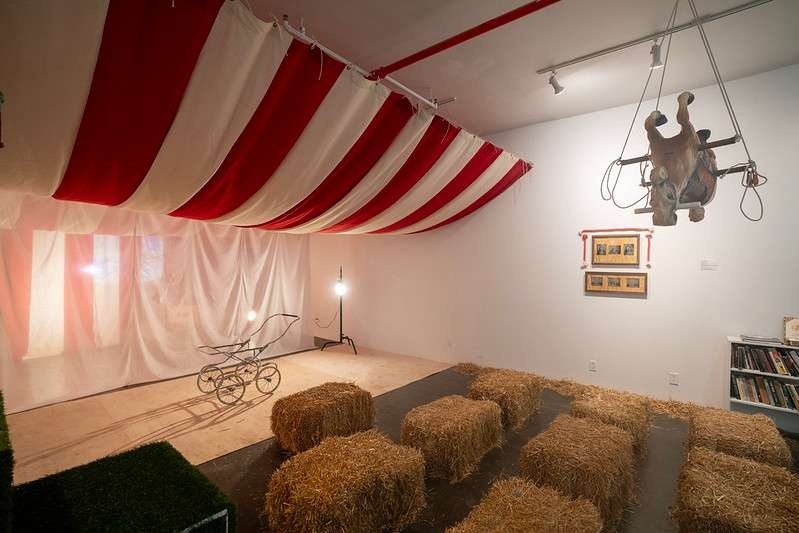New York City is home to the largest number of immigrants from Puebla, Mexico, which is also the hometown of Recess’s Session artist Manuel Molina Martagon. One of the most popular industries in New York, restaurants rely heavily on employing immigrant workers in all positions. In Molina Martagon’s project El Recreo, restaurant workers are offered a space to be acknowledged because of their work, but not defined by it—as is the case with many immigrant groups primarily seen as laborers who sustain a workforce. El Recreo is a place to hang out, enjoy a home-cooked meal, meet new people, or share stories about the job. It holds space for workers who may not always have a chance to be shown appreciation on a daily basis for their hard work. The artist explains he is “interested in people’s solutions,” as opposed to their problems. El Recreo asks the audience to recognize the restaurant worker, and immigrant workers in general, as great problem-solvers. Rather than focusing on the difficulties and strife that immigrants in New York face, here their solutions and their accomplishments are celebrated and rewarded. While he extracts simple day-to-day activities such as playing foosball or drinking a beer with friends as the nexus of El Recreo’s social backdrop, the text below considers a typical restaurant shift as a framework through which to reflect on certain common experiences shared by immigrants and restaurant workers in our city.
You arrive at work and prep your station, laying out your materials. You set up your time and plan your workday. You organize your tools and ingredients, deciding what will be just in and out of reach, so as to move most efficiently through your workspace. You arrange the space around you, deciding how you will move through the day in the most efficient way possible, maximizing time.
The immigrant experience is shaped by the process of re-defining, re-inventing, and re-configuring. Being in a new country means sacrificing part of oneself, deciding how to present another part to others, and choosing which of these pieces to reveal or not, and to whom. Earning a living often means stretching resources to the maximum. Navigating the inevitably intertwined challenges of life, work, communicating identity, and earning money becomes a complex balancing act of difficult but necessary decisions.
Your shift begins. You keep within the boundaries associated with the role of your job—as a cook you know when and where to move, or as a server you are aware of how to move and when to speak. You pass through the kitchen and restaurant floor half-visible, uniformed into a role that is recognized by the results of your labor: a plated dish or a cleaned and perfectly set table. You balance your own work with that of your co-workers, who depend as much on you as they do on themselves to get the job done. One order after the next, you complete each one as if overcoming a mini challenge, always prepared for the next, tackling multiple trials at once.
A restaurant operates based on a complex ecosystem of jobs that address very specific functions within the business, all of which are structured in order to provide service and a product to customers in a time-sensitive environment. We are all aware of cooks and waitstaff, but restaurants also depend on a large number of mostly invisible workers who clean the spaces when the restaurant is closed, or who prepare ingredients hours before a shift starts in order for kitchen staff to have as much ready in advance as possible. The social structure of most restaurants is defined along a hierarchy that places servers, hosts, bartenders, chefs, and managers/maître d’s at the top; their support staff of bussers and barbacks beneath them; line cooks and runners at an equal level or just below; and porters, dishwashers and cleaners at the bottom. Restaurant workers endure long hours, difficult physical tasks, and stress, while also moving through a maze of social roles that determine how they do their jobs and which jobs are made visible to the customer. Racial and class inequalities that exist in daily life are mirrored in each of these positions, furthering a secondary hierarchy and separation among workers based on the jobs they do. At the same time, restaurant workers depend on each other to complete their work. Despite the disparities that pervade a restaurant’s social structure, these spaces represent the success of teamwork and cooperation, the completion of each shift demonstrating daily feats of collective labor.
The rush winds down. You look at the clock. You reflect, become aware of time, realize you have about one hour left. You pause to breathe, look at your co-workers, crack jokes, have a drink. You appreciate your work and that of those around you.
Beyond simply providing necessary sustenance, food and food culture carries endless meanings in our lives. Family recipes transcend time in order to pass on traditions of cultural cuisine. We meet with friends for dinner in order to share conversation and a meal. We experience other cultures through their food, exploring our own palates while gaining an understanding of unfamiliar cuisines. While food will always represent deeply personal or memorable moments in our lives, what we may not always perceive is that food and our experiences associated with it is the product of someone else’s labor and time. At El Recreo, Molina Martagon asks us to take a step back, slow down, and appreciate the restaurant worker for who they are, whether we are one or not.
Before clocking out, you do the remaining sidework. You take care of your station for your next co-worker, and help them out so that they can be ready for their shift. You have finished a day of work, but know that other workers will be in your position soon. You ready the space for them in acknowledgement of the collective work that needs to be done.
About the artist
Explore/Archive
See allOctober 2025
streamlined reflections, courtesy of noise canceling headphones
Gabrielle Rucker
Gabrielle Rucker reflects on the radical intimacy and auditory life at the heart of Deli Radio
July 2025
Tell My Jockey: CUNTRY’s Discourse From the Horse’s Mouth
Ericka Pérez
Assembly fellow Ericka Pérez reflects on clowning, resistance, and CUNTRY’s radical refusal to perform.
April 2025
The Second Head of Hercules: Art and Resistance Through Four Years of Upheaval
Shakeem Floyd
written in conjunction with artist Onyedike Chuke's Session x Assembly project, The Forever Museum Archive: Circa 2020_An Object





